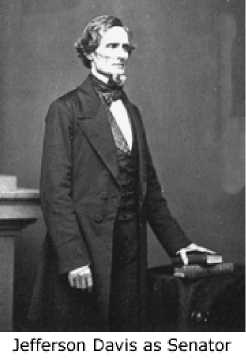By February of 1861 the Confederate States of America had been organized with their capital at Montgomery, Alabama, though it would later be moved to the larger city of Richmond. Jefferson Davis of Mississippi was sworn in as provisional first president. A cabinet was formed and the new government began to function within three months of the election of Abraham Lincoln as president, the event that precipitated the action.

The Constitution of the Confederate States of America was adopted on March 11, 1861. As much of it was taken directly from the United States Constitution, the process of creating it required far less time than had been needed in Philadelphia in 1787. The Preamble announced the creation of sovereign and independent states that would form a "permanent federal government," thus incorporating the states' right doctrine from the outset. The structure of the Confederate government was essentially the same as that of the United States, with the exception that the president was limited to one six-year term. The rights guaranteed in the Bill of Rights were enumerated in the basic document. A section of that article stated that "No _ law denying or impairing the right of property in negro slaves shall be passed." The Confederate Constitution also extended the right of slave ownership to any territories that might join the Confederacy in the future.
All those events occurred before Abraham Lincoln left Illinois. President Buchanan did his best to hold things together, but obviously a crisis was at hand, and the new president would have to deal with it. As Lincoln made his way slowly from Springfield to Washington via New York State, he was met by well-wishers along the way-including a little girl who had urged him to grow beard to hide his ugliness. He eventually was smuggled into Washington in the middle of the night, since the city found itself in the midst of Confederate sympathizers.
President Lincoln took office facing an unprecedented crisis-and the Constitution offered no guidance on how to confront the situation. Lincoln put together a balanced cabinet, headed by Secretary of State William Seward, who hoped to conciliate the South. Secretary of the Treasury Salmon Chase, who had also sought the Republican nomination in 1860, was a spokesman for abolitionists. His first Secretary of War was Simon Cameron of Pennsylvania, but he was soon replaced by Edwin Stanton. Edward Bates of Missouri became Lincoln's Attorney General. 80
The president's problem was how to enforce the Constitution, the Supreme Law of the Land, without being accused of starting a war. His dilemma lay in the fact that if he ignored Southern occupation of Federal territory, he would be, in effect, recognizing Southern independence. On the other hand, the Confederacy also faced a dilemma: If it allowed President Lincoln to treat what they considered former Federal property as still belonging to the United States, then they would be acknowledging that they were not sovereign over such territory. Lincoln decided to place the burden of resolving the issue on the South.
Since South Carolina was the first state to secede, President Lincoln focused his attention on Fort Sumter in Charleston Harbor. Lincoln's decision to re-supply the fort with an unarmed vessel shifted the dilemma to the Confederacy. If the Confederate government allowed a Union vessel to enter the harbor and re-supply the fort, it would be acknowledging that it lacked full sovereignty over its own territory. If, on the other hand, the South were to use force to prevent the fort from being re-supplied by firing on an unarmed ship, then they would be held guilty of firing the shot that started the war. In the end the Confederacy took the second option.

Lincoln's decision to send a ship full of provisions but without armament to supply the hungry garrison led the Confederate government to decide that it could not allow what it deemed a foreign country to enter its territory without permission. Thus General P. G.T. Beauregard was ordered not to allow the resupply to take place, and to fire on Fort Sumter. Lincoln positioned the Confederacy in such a way that they were obliged to fire the first shot on the American flag, which occurred in April 12, 1861.
The Confederates shelled Fort Sumter for several hours, causing much damage but no serious casualties. The Commander, Major Anderson, surrendered the fort the next day. Lincoln then called for 75,000 3-month volunteers to end the "Insurrection." This caused four upper South slave states to secede: North Carolina, Virginia, Tennessee and Arkansas. Southerners considered Lincoln's call an act of aggression that denied them their right to self-determination. In Lincoln's view secession was undemocratic because it challenged the results of a freely held election.81 82 In 1861, Northerners were committed to saving the Union, not to freeing the slaves. The fact that the South had fired on the United States flag was enough to send thousands of young men to volunteer to fight for the Union.
Both sides expected a short war—neither was prepared for a drawn-out conflict. Both Yankees and Confederates expected it to be over in a matter of weeks. One Southerner held up a handkerchief and declared he would be able to soak up all the blood that would be shed with that single piece of cloth.
92




 World History
World History









